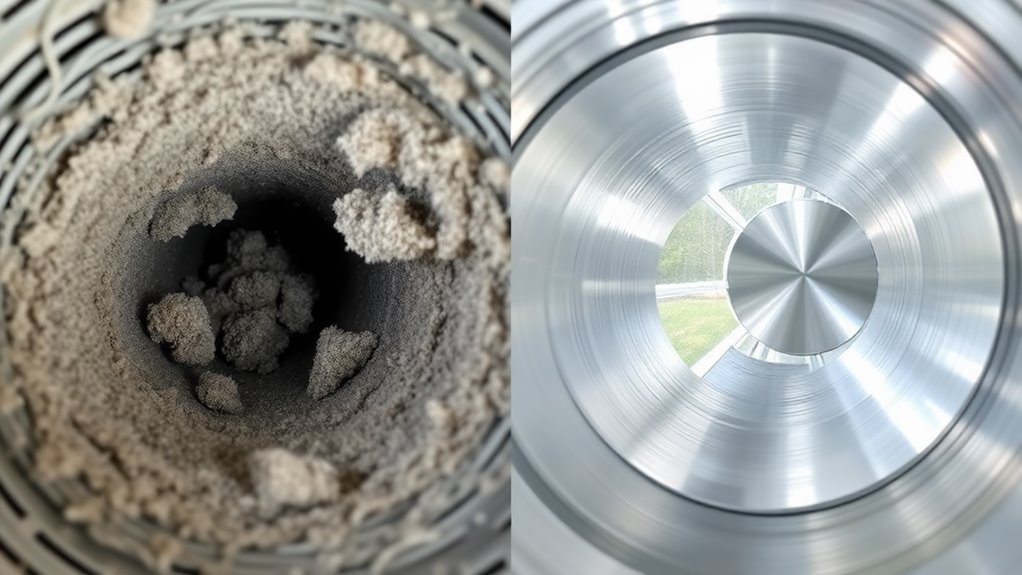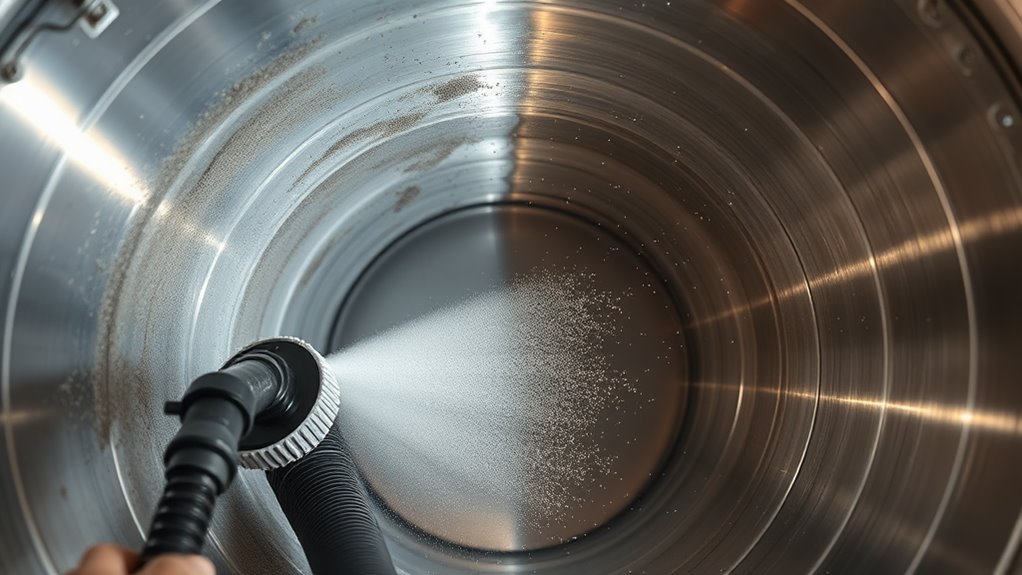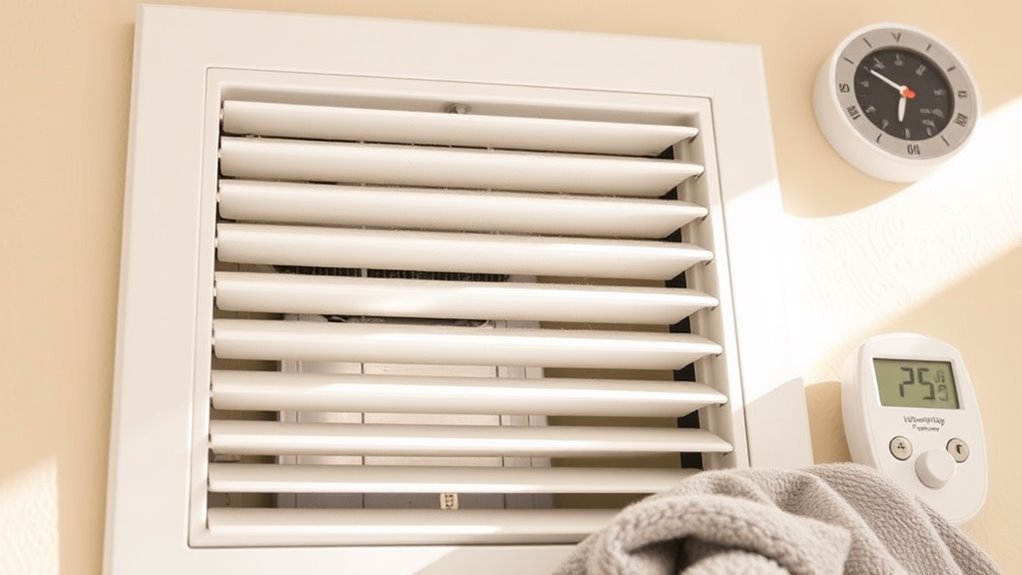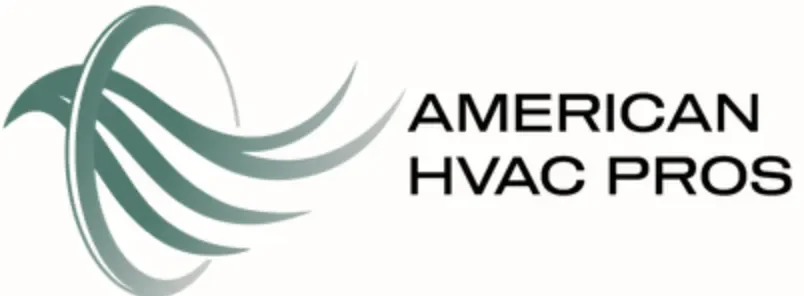You'll need professional air duct cleaning when you notice visible dust from vents, increased allergy symptoms, musty odors, or rising energy bills. A thorough cleaning removes harmful contaminants like dust, mold, and pet dander while improving your HVAC system's efficiency. Professional services use specialized equipment including HEPA filtration and rotating brushes to guarantee complete cleaning. Understanding the cleaning process and maintenance requirements will help you protect your home's air quality and system performance.
Signs Your Air Ducts Need Professional Cleaning

Dust buildup in your home's air ducts won't always be obvious, but several telltale signs can indicate it's time for a professional cleaning. You'll notice visible dust blowing from your vents, increased allergy symptoms, or a musty odor when your HVAC system runs. Dark lines around your vent covers suggest significant debris accumulation.
A proper duct inspection can reveal the extent of contamination and determine appropriate cleaning frequency. Watch for higher energy bills, as clogged ducts force your system to work harder. If you've recently completed a renovation project or haven't had your ducts cleaned in over three years, schedule a cleaning. You might also observe uneven airflow between rooms or persistent dust on furniture shortly after cleaning.
Health Benefits of Clean Air Ducts and Vents
Clean air ducts dramatically reduce your exposure to airborne pollutants that can trigger respiratory issues like asthma and allergies. You'll notice immediate improvements in your indoor air quality once professional duct cleaning removes accumulated dust, mold spores, and other contaminants. Your HVAC system will distribute cleaner air throughout your home, helping you and your family breathe easier while reducing common respiratory symptoms.
Reduced Respiratory Health Issues
Regular air duct maintenance greatly reduces respiratory health issues by removing accumulated allergens, pathogens, and irritants from your home's ventilation system. You'll experience immediate allergy relief and breathing ease when these harmful particles are eliminated from your indoor air.
Clean ducts provide measurable improvements to respiratory health:
- Decreased frequency of asthma attacks and respiratory infections
- Reduced congestion, coughing, and throat irritation
- Lower risk of developing allergic reactions to dust and mold
- Minimized exposure to airborne bacteria and viruses
- Better sleep quality due to cleaner breathing air
Your respiratory system works more efficiently when it's not constantly fighting airborne contaminants. Professional duct cleaning removes these triggers at their source, creating a healthier indoor environment that supports ideal lung function and reduces strain on your immune system.
Better Indoor Air Quality
Beyond specific respiratory benefits, maintaining spotless air ducts and vents improves your home's general indoor air quality in measurable ways. You'll notice reduced dust accumulation on surfaces and decreased airborne particles that can trigger allergies. When combined with air purifiers and indoor plants, clean ducts create a thorough air quality management system.
| Air Quality Factor | Clean Ducts | Dirty Ducts |
|---|---|---|
| Particle Count | <1000/m³ | >3000/m³ |
| Dust Settlement | Minimal | Heavy |
| VOC Levels | Low | Raised |
| Mold Risk | Negligible | Significant |
You're creating a healthier living environment by preventing the recirculation of contaminants throughout your home. Regular duct cleaning works synergistically with your HVAC system's filtration, maximizing its effectiveness in maintaining ideal indoor air quality.
The Professional Cleaning Process Explained

Professional air duct cleaning follows a systematic, multi-step process that guarantees thorough removal of contaminants from your HVAC system. The cleaning techniques involve specialized equipment used by certified technicians to access and clean every component of your ductwork.
Certified HVAC technicians use specialized equipment and follow systematic protocols to ensure complete removal of contaminants from your home's ductwork.
- Initial system inspection using video cameras to assess contamination levels
- Negative air pressure application with industrial-grade vacuum equipment
- Mechanical agitation of ducts using rotating brushes and air whips
- HEPA filtration to capture dislodged particles and prevent re-circulation
- Final sanitization treatment to eliminate remaining bacteria and mold
The entire process typically takes 3-5 hours, depending on your system's size and condition. You'll notice immediate improvements in airflow and system efficiency once technicians complete the cleaning process using these professional-grade tools and methods.
Cost Factors and Service Packages
When evaluating air duct cleaning services, you'll find that costs vary based on several key factors, including your home's square footage, system complexity, and contamination levels. Basic service pricing typically starts at $300-$500 for standard residential systems, while larger homes can exceed $1,000.
Most companies offer tiered package options to suit different needs and budgets. Entry-level packages usually include main duct cleaning and basic sanitization. Mid-tier services add vent cleaning, deodorizing, and camera inspections. Premium packages incorporate advanced antimicrobial treatments, HVAC component cleaning, and extended warranties. You'll need to assess add-on services like dryer vent cleaning, mold remediation, or rodent waste removal separately, as these aren't typically included in standard packages. Always request itemized quotes to compare services effectively.
Maintaining Air Quality Between Professional Cleanings

Regular maintenance between professional cleanings plays an essential role in preserving your home's air quality. You'll need to implement several key practices to maintain ideal airflow and reduce contaminant buildup in your ductwork.
- Replace your HVAC air filters every 60-90 days, or monthly if you have pets
- Monitor and maintain indoor humidity levels between 30-50%
- Vacuum registers and vents weekly using a brush attachment
- Keep furniture and objects away from air vents to guarantee proper airflow
- Clean return air grilles monthly to prevent dust accumulation
Air filter maintenance directly impacts your system's efficiency and indoor air quality. Install a humidity control system if you live in an area with significant moisture fluctuations. By following these practices, you'll extend the time between professional cleanings while maintaining healthier indoor air.
Common Contaminants Found in Residential Ductwork
Your home's ductwork commonly harbors three main types of contaminants: accumulated dust mixed with dead insects, colonies of mold that thrive in damp conditions, and significant amounts of pet hair and dander. You'll typically find dust and insect debris collecting at duct seams and corners, while mold tends to develop in areas where condensation forms, particularly near cooling coils and drain pans. Pet hair can penetrate deep into your duct system, especially if you've had furry companions for several years, creating dense accumulations that reduce airflow efficiency.
Dust and Dead Insects
Two of the most prevalent contaminants in residential ductwork are dust particles and dead insects. When you don't address dust accumulation regularly, these particles can greatly impact your home's air quality. Insect infestations can lead to dead bugs collecting in your ducts, creating further health concerns.
Common issues you'll encounter include:
- Fine dust particles from everyday activities
- Dead insects that entered through vents or small openings
- Decomposed insect parts that break down into smaller particles
- Dust mites feeding on accumulated debris
- Allergens from both dust and insect remains
These contaminants can trigger allergies, respiratory issues, and unpleasant odors in your home. Regular inspection and cleaning of your ductwork will prevent these particles from circulating through your HVAC system and into your living spaces.
Mold Growth Patterns
Beyond dust and insect contamination, mold growth presents a significant biological hazard in residential ductwork. You'll typically find these fungi developing in areas where condensation forms, particularly near cooling coils and in sections with poor insulation. Black, green, or white patches indicate active colonies that require immediate mold removal intervention.
The pattern of mold growth often follows moisture paths within your ducts. You'll notice it clustering around seams, joints, and areas where water can pool. Proper moisture control is vital, as spores can spread throughout your entire HVAC system when conditions are favorable. Dark, humid environments with temperatures between 60-80°F create ideal conditions for mold proliferation. Identifying these patterns early helps prevent extensive contamination and guarantees effective remediation strategies.
Pet Hair Accumulation
While many contaminants can accumulate in residential ductwork, pet hair presents a unique challenge due to its persistent nature and volume. Your HVAC system's air filters capture some pet hair, but significant amounts still enter the ductwork, creating potential allergy triggers throughout your home.
Common issues associated with pet hair in your ducts include:
- Reduced airflow efficiency due to hair clumps
- Increased strain on HVAC system components
- Higher concentration of pet dander in circulated air
- Formation of dense hair mats at vent openings
- Amplified allergic reactions for sensitive individuals
Professional pet hair removal requires specialized equipment and techniques beyond standard duct cleaning methods. You'll need rotating brushes, high-powered vacuums, and antimicrobial treatments to effectively address this issue. Regular maintenance becomes especially important if you have multiple pets or long-haired breeds.
Energy Savings and System Performance Benefits
Regular air duct cleaning greatly improves your HVAC system's energy efficiency and general performance. When dust and debris accumulate in your ductwork, your system must work harder to maintain desired temperatures, consuming more energy and increasing your utility bills. Clean ducts allow air to flow freely, reducing strain on your HVAC components and promoting system longevity.
You'll notice immediate benefits after professional duct cleaning, including more consistent heating and cooling throughout your home, faster temperature adjustments, and reduced cycling frequency. Your system won't need to compensate for blockages, leading to peak performance at lower energy costs. Furthermore, clean ducts help prevent dust from circulating back into your living spaces, protecting your HVAC components from unnecessary wear and extending their operational lifespan.
Frequently Asked Questions
How Long Does a Typical Air Duct Cleaning Service Take?
You can expect a thorough air duct cleaning duration to take between 3 to 5 hours for an average-sized home. The time varies based on your system's size, accessibility, and level of contamination. For larger homes or complex HVAC systems, it might take up to 8 hours. Cleaning frequency typically ranges from every 3-5 years, but you'll need more frequent cleanings if you have pets, allergies, or live in a dusty area.
Can I Stay in My Home During the Duct Cleaning Process?
You can stay in your home during duct cleaning, but it's recommended to avoid the immediate work areas for safety and comfort. While technicians implement duct cleaning precautions, the process can temporarily impact air quality by stirring up dust and debris. It's best to keep children, elderly, and those with respiratory conditions away from active cleaning zones. You'll likely experience some noise and minimal disruption in areas where work is being performed.
How Often Should I Schedule Professional Air Duct Cleaning Services?
You should schedule professional air duct cleaning every 3-5 years, according to EPA frequency recommendations. However, you'll need more frequent cleanings if you have pets, allergies, or recent home renovations. Regular maintenance offers significant health benefits, including reduced indoor allergens and improved air quality. If you notice visible mold, dust buildup, or unexplained respiratory issues, don't wait for the standard timeline—schedule a cleaning immediately.
Will Duct Cleaning Damage My HVAC System or Home's Walls?
Professional duct cleaning won't damage your HVAC system or walls when performed correctly. Qualified technicians follow strict duct cleaning safety protocols and use specialized equipment designed for HVAC maintenance. They'll access your ducts through existing openings and use controlled vacuum pressure to prevent structural stress. However, it's essential to hire certified professionals, as inexperienced cleaners might use excessive force or improper tools that could cause damage.
Do Pets Require More Frequent Air Duct Cleaning Services?
Yes, if you have pets, you'll need more frequent duct cleaning. Pet hair easily accumulates in your HVAC system's ductwork, creating blockages and reducing airflow efficiency. This buildup can also trigger allergy concerns for both humans and pets, as dander and fur circulate through your home's air supply. While most homes need duct cleaning every 3-5 years, households with pets should consider cleaning every 2-3 years to maintain ideal air quality.

